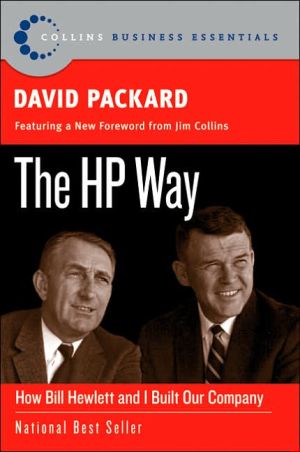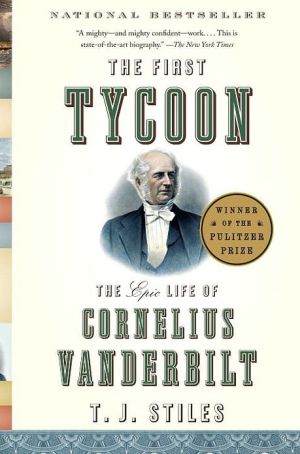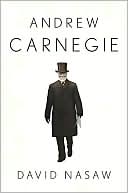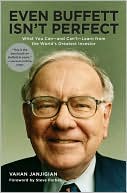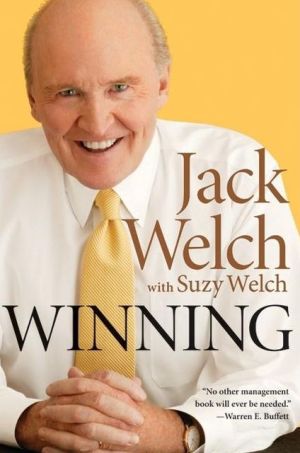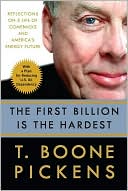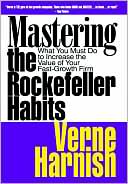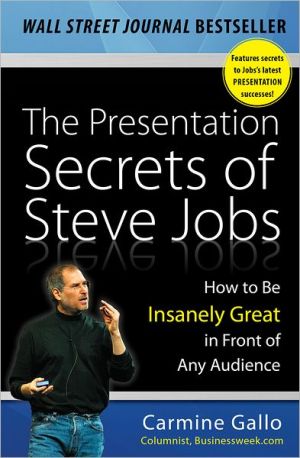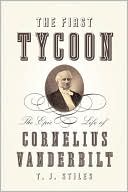The HP Way: How Bill Hewlett and I Built Our Company
Much more personal than standard corporate histories, David Packard's The HP Way provides insights into managing and motivating people and inspiration for would–be entrepreneurs. This bestselling classic joins the Collins Business Essentials line–up with a new Note from Steve Jobs.\ From a one–car–garage company to a multibillion–dollar industry, the rise of Hewlett–Packard is an extraordinary tale of vision, innovation and hard work. Conceived in 1939, Hewlett–Packard earned success not only...
Search in google:
Much more personal than standard corporate histories, David Packard's The HP Way provides insights into managing and motivating people and inspiration for would–be entrepreneurs. This bestselling classic joins the Collins Business Essentials line–up with a new Note from Steve Jobs. From a one–car–garage company to a multibillion–dollar industry, the rise of Hewlett–Packard is an extraordinary tale of vision, innovation and hard work. Conceived in 1939, Hewlett–Packard earned success not only as a result of its engineering know–how and cutting–edge product ideas, but also because of the unique management style it developed – a way of doing things called 'the HP way'. Decades before today's creative management trends, Hewlett–Packard invented such strategies as 'walk–around management', 'flextime', and 'quality cycles'. Always sensitive to the needs of its customers and responsive to employee input, Hewlett–Packard earned massive steady growth that far outshone its competitors' vacillating fortunes, even with radically different products from those responsible for its initial boom. For entrepreneurs and managers alike, the wisdom found in these pages is invaluable if they want their businesses to gain steady growth and consistent success. New York Times Book Review An unswerving chronology of the life and most good times of Hewlett-Packard, from its notional beginnings . . . to its luminous present.
Pueblo to Stanford\ As we get older we have the opportunity to look back over many years and see how certain events, seemingly unimportant at the time, had a profound effect in shaping our business or professional careers.\ In my own case there were two such events. One occurred in the summer of 1929 when I was given a tour of Stanford University. This introduction to Stanford led to my decision to attend the university. The second event, related to the first, was becoming acquainted with Professor Fred Terman at Stanford. It was Fred who sparked my interest in electronics and who later encouraged and helped Bill Hewlett and me go into business for ourselves. His interest and faith in our abilities, even at our young age and in the midst of the Great Depression, gave us confidence and helped set a course for us.\ I was born in Pueblo, Colorado, in 1912. My father was a lawyer and my mother a high school teacher. They met at Colorado College in Colorado Springs, and after they were married they moved to Pueblo, which was my father's home. My younger sister, Ann Louise, was born in 1915.\ Pueblo in 1912 resembled less a midwestern farm community than it did a western frontier city or border town. There was a steel mill and several foundries that smelted ore from Leadville and other mines in the Rocky Mountains to the west. Pueblo was tough and violent, with immigrant workers, a few gangsters, and lots of brothels and saloons. Street fights and shootings were not uncommon.\ We lived on the north side of the city right next to the prairie. I could cross the street in front of our house and find horned toads (which are almost extinct today) and wild onionsand cactus, which often gave shelter to rattlesnakes.\ We could look across the prairie and see Pikes Peak about fifty miles to the north, and about thirty miles to the west, the Wet Mountain Range. I spent many hours roaming the prairie, sometimes with childhood friends, sometimes alone, until my high school years, when studies and school activities consumed most of my time. But in those early years of roaming, my love of nature was born.\ One of my early recollections of Pueblo was the great flood of 1921. I recall going downtown with my father and seeing mud about four feet deep. Another memorable sight was a railroad boxcar stuck in the second-floor window of one of the main buildings. A fleet of four-wheel-drive army trucks was brought in to haul the mud and debris out of the city and dump it in the prairie about a mile north of our house. A number of kids from our neighborhood went out and sifted through the mud, intrigued with the possibility of finding something of value. But I don't recall finding anything useful.\ Our house in Pueblo was on the corner of Twenty-ninth Street and High Street. It was set back from Twenty-ninth Street to provide for a large yard. The yard was divided into two roughly equal sections by a row of lilac bushes. In the front section was a rose arbor and a bed of peonies, with the rest in lawn. In the rear section were some fruit trees, a vegetable garden, and a pool near a wildflower garden.\ My father had no interest in gardening, and so the entire garden was my mother's project. I started helping my mother when I was quite young, and gardening became a lifelong interest for me. I also found it to be an excellent recreational activity, for one quickly forgets the troubles of the world when absorbed with gardening. As an adult, wherever we were located for a period of time, I had a garden, and now that I am retired, I enjoy devoting more time to gardening projects. I also have an avid interest in farming and ranching.\ Early Experiments\ As a very young child, I must have had some aptitude for science and math; my parents did nothing to discourage me--I spent hours curled up with the family World Book Encyclopedia, studying every entry on the natural sciences. I also conducted my own experiments. I remember that while quite young I got a thrill from looking at pictures of railroads, bridges, motors, generators, and other mechanical and electrical equipment. I tried to simulate some of these devices with small-scale models in our backyard. An older boy, Lloyd Penrose, lived across the alley behind us. His mother and sister had tuberculosis, and Lloyd worked in the evenings at an amusement park across town to help support them. He also helped me with my models and devices, and we became good friends. Later on, since he could not afford to go to college, Lloyd joined the navy, and we kept in touch for many years. The HP Way: How Bill Hewlett And I Built Our Company. Copyright © by David Packard. Reprinted by permission of HarperCollins Publishers, Inc. All rights reserved. Available now wherever books are sold.
Acknowledgments Prologue Chapter 1: Pueblo to Stanford Chapter 2: Friendship with Hewlett Chapter 3: Garage Becomes Workshop Chapter 4: Gaining More Space Chapter 5: From Partnership to Corporation Chapter 6: Growth from Profit Chapter 7: Commitment to Innovation Chapter 8: Listening to Customers Chapter 9: Trust in People Chapter 10: Growing the Organization Chapter 11: Managing the Organization Chapter 12: Responsibility to Society Epilogue Appendix 1: Historical Highlights of Hewlett-Packard Company Appendix 2: Product Innovation at HP Appendix 3: Vintage Charts
\ New York Times Book ReviewAn unswerving chronology of the life and most good times of Hewlett-Packard, from its notional beginnings . . . to its luminous present.\ \ \ \ \ Library JournalHewlett-Packard is a high-tech company with over $25 billion in sales; the Hewlett-Packard way has obviously been quite successful. Here, one of the company's founders tells the story of its growth. Packard frequently becomes nostalgic, such as when talking about his first vacuum tube. He explains why Hewlett-Packard follows strong management practices: management by objectives, educational subsidies for employees, profit sharing, and giving authority to employees closest to the customers. Packard also served as a Defense Department official and in doing so chose to give $20 million to charity to avoid ethical conflicts. The company history Packard relates is, however, an uncritical review. The cassettes, narrated by Martin Bookspan, are of limited use because they offer little discussion of ideas that a person in business might adopt. Not an important purchase.-Mark Guyer, Stark Cty. Dist. Lib., Canton, Ohio\ \
